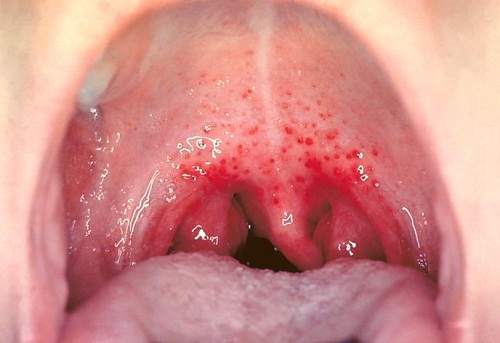There are a number of potential causes of red spots on roof of mouth. Some of these issues are only small inconvenience, but others might indicate a serious health issue that needs to be taken care of seriously. You need to see your doctor to determine the cause of the spots and the severity of the issue. The following are a few possible causes of these red spots as well as how each condition would be treated.

Causes and Treatments for Red Spots on Roof of Mouth
1. Canker Sores
Canker sores affect the majority of people at some time and they can occur on the roof of your mouth, but are more commonly found on the lips or inner cheeks. These are typically due to eating certain foods, stress or being in contact with irritants. They begin as red small bumps and frequently develop white in the center.
- Treatment
You can usually ignore a canker sore as it goes away by itself. You can also relieve discomfort with an over-the-counter analgesic ointment. Mouthwash can also temporarily numb your sores. In some cases, you may need a prescription for medication with lidocaine or aphthasol.
2. Candidiasis
Oral candidiasis or thrush is a fungal overgrowth that leads to white patches and red spots on roof of mouth. This is particularly common among those with diabetes or who wear dentures.
- Treatment
Thrush treatment commonly involves taking prescription antifungal medications for 10 to 14 days. They can be found in liquids, lozenges or tablets. In some cases, this issue will indicate another medical problem, so you may need to visit a doctor as well as a dentist.
3. Coxsackievirus Infection
This is the virus responsible for hand, foot and mouth disease and can lead to painful red spots and blisters along the roof of your mouth in addition to your feet and hands. It can affect all ages, but is most common among those under five.
- Treatment
There is not a specific treatment for a coxsackievirus infection. Antibiotics do not typically help. Instead, doctors usually suggest over-the-counter fever reducers or pain relievers as well as fluids and rest.
4. Oral Herpes
Oral herpes typically includes red spots on roof of mouth followed by a white or gray ulcer. The ulcers may take longer to develop than the spots. This infection is typically due to the type-1 herpes simplex virus or HSV-1. It is transmitted by contact with an infected person’s saliva.
- Treatment
Ibuprofen or acetaminophen can be used to treat muscle aches or fever. You should also drink a lot of water to prevent dehydration. Your doctor may also prescribe a medication for fever. Pain relief may be via a topical anesthetic like viscous lidocaine. There is an IV or oral medication, but only for those with weakened immune systems, severe disease or those who are under 6 weeks old. In certain cases, people with oral herpes may need to be admitted to the hospital. This includes those younger than 6 weeks old, with a severe local infection, with an infection that spreads to the other organs, with weakened immune systems or those who are dehydrated.
5. Injuries
Hitting your mouth with a hard food item, like a pretzel, can lead to red spots. This would be a temporary injury and can cause multiple spots.
- Treatment
Red spots caused by accidentally hitting the roof of your mouth usually go away within one to two weeks. You can suck on an ice pop or piece of ice frequently. Also, try rinsing with salt water. While healing, opt for soft foods that are easy to swallow and avoid those that may cause stinging, like spicy foods, tomatoes and citrus juices or fruits.
6. Lichen Planus
Lichen planus involves a chronic lesion that is itchy and inflammatory or a rash within the mouth as well as on the skin. Except red spots on roof of mouth, the lesions may be lace-like or white spots. It isn’t contagious and can’t lead to cancer.
- Treatment
There is no treatment for lichen planus, so just clear up the rash and ease your pain while preventing secondary infections. To reduce pain, avoid eating foods that are acidic or spicy as they can cause irritation. Don’t eat crusty bread or other sharp food. Choose bland and soft foods like porridge or mashed potatoes. Don’t drink alcohol. Try to keep using your standard toothpaste but avoid mouthwashes with alcohol.
7. Petechiae
Petechiae is when small blood vessels underneath the skin rupture. It can be due to bleeding disorders, infections or excess pressure on the blood capillaries. This condition will include tiny purple dots on the skin’s surface.
- Treatment
Petechiae can be treated using Arnica Montana, a homeopathic drug. You can also try taking dandelion roots as these improve the functioning of your liver. Since this helps your blood’s coagulation properties, it can work to prevent petechiae spots from occurring.
8. Erythroplakia
Erythroplakia may involve red spots on roof of mouth, but it most frequently includes a red patch along the gums or floor of the mouth. This condition may indicate a risk of developing cancer, thus you should always see your doctor right away if you notice it. Experts aren’t sure what causes erythroplakia but think it is associated with smoking or alcohol use. It may also be due to chronic irritation or poor nutrition.
- Treatment
The treatment options for erythroplakia can vary greatly. It’s always important to keep frequent follow-up appointments with the doctor. Sometimes surgical removal is necessary and in rare cases, laser surgery or cryosurgery is needed.
